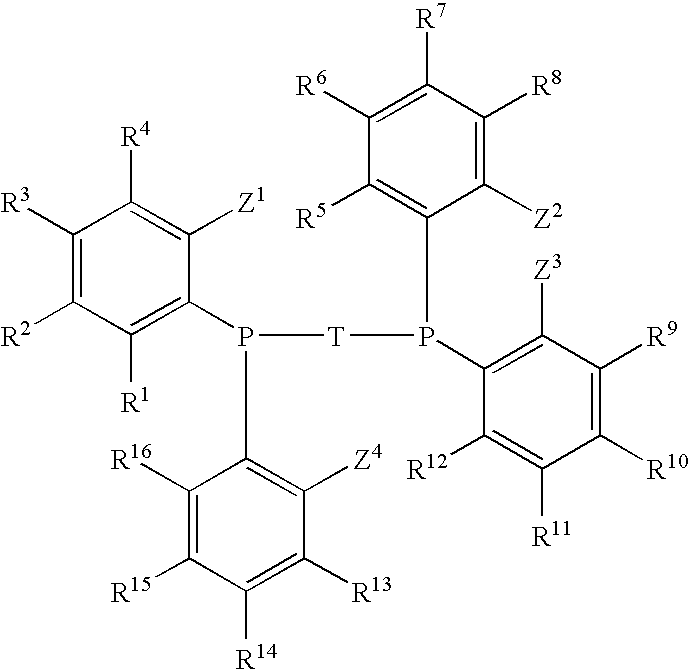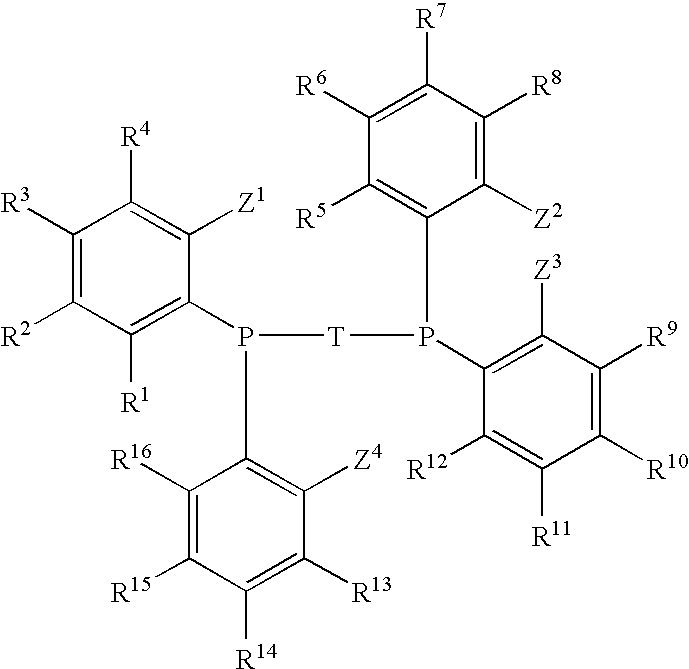Phosphine Ligand-Metal Compositions, Complexes, and Catalysts For Ethylene Trimerizations
- Summary
- Abstract
- Description
- Claims
- Application Information
AI Technical Summary
Benefits of technology
Problems solved by technology
Method used
Image
Examples
examples
[0214]General: All air sensitive procedures were performed under a purified argon or nitrogen atmosphere in a Vacuum Atmospheres or MBraun glove box. All solvents used were anhydrous, de-oxygenated and purified according to known techniques (see for example, D. D. Perrin & W. L. F. Armarego Purification of Laboratory Chemicals, 3rd Ed., (Pergamon Press: New York, 1988)). All ligands and metal precursors were prepared according to procedures known to those of skill in the art, e.g., under inert atmosphere conditions, etc. Ethylene oligomerization experiments were carried out in a parallel pressure reactor, described in U.S. Pat. Nos. 6,306,658, 6,455,316 and 6,489,168, and in U.S. application Ser. No. 09 / 177,170, filed Oct. 22, 1998, WO 00 / 09255, and a parallel batch reactor with in situ injection capability, as described in WO 04 / 060550, and U.S. Application No. 2004 / 0121448, each of which is incorporated herein by reference.
[0215]Quantitative analysis of the liquid olefin products ...
example
Bis[di(2-methoxyphenyl)phosphino]methane (A6)
[0227]
[0228]To a solution of bis(dichlorophosphino)methane (100 mg, 0.46 mmol) in 10 mL THF cooled to −30° C. was added dropwise a solution of 1.90 mL (1.90 mmol) of 1.0 M 2-methoxyphenylmegnesium bromide in THF. This solution was then allowed to warm-up to room temperature overnight (ca. 12 hrs). Reaction was diluted by addition of 10 mL of ether and the quenched with 10 mL of saturated solution of aq. NH4Cl. The organic phase was separated and the aqueous phase was washed with ether (3×10 mL). The organic layers were combined, dried over MgSO4 and concentrated. The residue was purified by silica-gel chromatography (90:10, hexanes:EtOAc), to give 95 (41% yield) mg of bis[di(2-methoxyphenyl)phosphino]methane (A6) as a white solid.
[0229]Ligand A1 was also synthesized using Method C.
Selective Ethylene Oligomerization Examples in a 96-Well Format
General Protocols
[0230]Ethylene oligomerization reactions were performed in a 96-well format usin...
example 2.1
[0251]Method A. The reactor was then closed, 0.100 mL of a 200 mM solution of MMAO-3A in toluene and 4.85 mL of toluene were injected into the pressure reaction vessel through a valve. The temperature was then set to 80° C., and the stirring speed was set to 800 rpm, and the mixture was exposed to ethylene at 100 psi (0.67 MPa) pressure. An ethylene pressure of 100 psi (0.67 MPa) in the pressure cell and the temperature setting were maintained, using computer control, until the end of the selective oligomerization experiment.
PUM
| Property | Measurement | Unit |
|---|---|---|
| composition | aaaaa | aaaaa |
| chemical reaction | aaaaa | aaaaa |
| structure | aaaaa | aaaaa |
Abstract
Description
Claims
Application Information
 Login to View More
Login to View More - R&D
- Intellectual Property
- Life Sciences
- Materials
- Tech Scout
- Unparalleled Data Quality
- Higher Quality Content
- 60% Fewer Hallucinations
Browse by: Latest US Patents, China's latest patents, Technical Efficacy Thesaurus, Application Domain, Technology Topic, Popular Technical Reports.
© 2025 PatSnap. All rights reserved.Legal|Privacy policy|Modern Slavery Act Transparency Statement|Sitemap|About US| Contact US: help@patsnap.com



